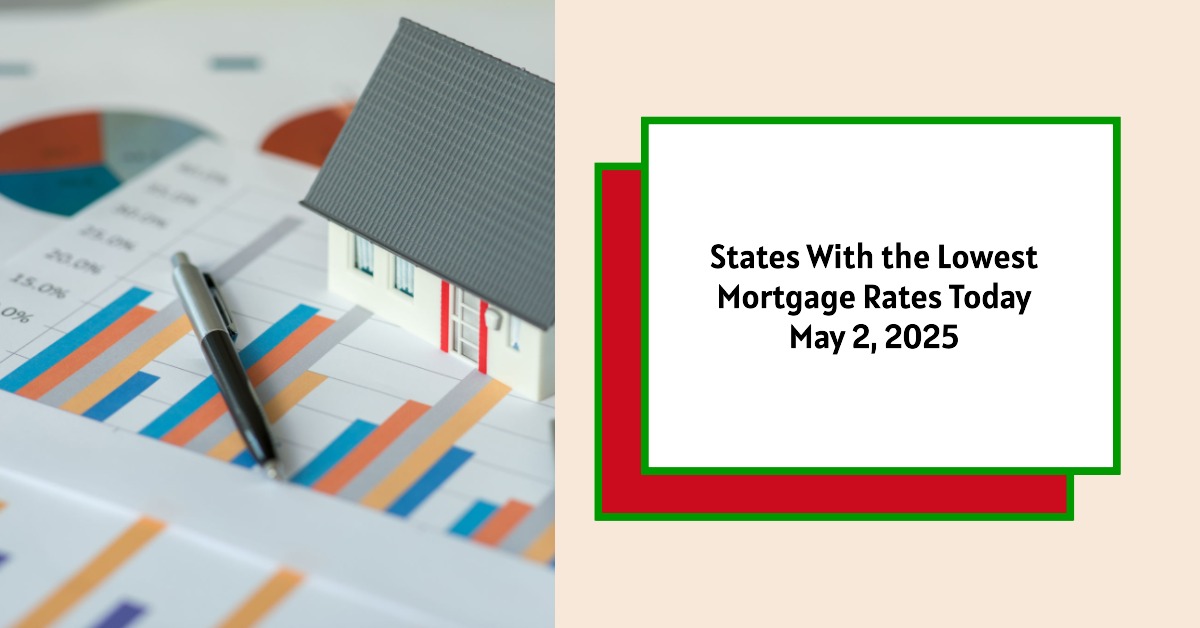If you're in the market for a home, you're probably glued to mortgage rates! As of today, May 2, 2025, the states with the lowest mortgage rates for a 30-year new purchase are New York and Washington. Following closely behind, you'll find relatively low rates in Tennessee, Texas, California, Florida, Michigan, North Carolina, and Pennsylvania. These nine states showed average mortgage rates hovering between 6.68% and 6.85%.
Now, let's dive a little deeper and figure out why these variations exist, and what you can do to snag the best rate possible.
States With the Lowest Mortgage Rates Today – May 2, 2025
Why Do Mortgage Rates Vary by State?
It's a fair question! Why isn't there just one national rate for everyone? Well, a bunch of factors play a role. Think of it like this: each state has its own unique financial “flavor.”
- Lender Presence: Not every lender operates in every state. Some focus on specific regions. This creates varying levels of competition, which directly impacts rates. More competition usually means better rates for you!
- Credit Scores: The average credit score within a state can influence rates. States with higher average credit scores might see slightly lower rates overall.
- Average Loan Size: This one is pretty straightforward. The average amount people are borrowing in a state can affect the rates lenders offer.
- State Regulations: Each state has its own set of rules and regulations governing the mortgage industry. These regulations can influence the costs for lenders, which they might pass on to borrowers in the form of slightly higher rates.
- Lender Risk Management: At the end of the day, lenders are trying to manage risk. If they perceive a higher level of risk in a particular state (maybe due to economic factors or housing market volatility), they might adjust rates accordingly.
As an expert in this field for years, I've seen these subtle differences play out time and time again. It's never a bad idea to stay vigilant, and do your own research.
The National Picture: A Quick Overview
Before we get too deep into state-by-state specifics, let's zoom out and look at the national trends. As of today:
- The national average for a 30-year fixed-rate mortgage for new purchases is around 6.88%.
It's been a bit of a rollercoaster recently. Rates jumped up in early April, hitting a high of 7.14% – the highest since May 2024. Before that, in March, we saw a low of 6.50%, the cheapest average of 2025. Remember September? Rates hit a two-year low of 5.89%.
Here's a quick look at national averages across different loan types:
| Loan Type | New Purchase Rate |
|---|---|
| 30-Year Fixed | 6.88% |
| FHA 30-Year Fixed | 7.33% |
| 15-Year Fixed | 5.93% |
| Jumbo 30-Year Fixed | 6.79% |
| 5/6 ARM | 7.10% |
Source: Zillow
States With The Lowest Rates: A Closer Look
Let's take a closer look at the states offering the most attractive mortgage rates today. Remember, these are averages, and your individual rate will depend on your specific financial situation.
- New York: Consistently a competitive market, New York often sees lower rates due to high demand and a large number of lenders vying for business.
- Washington: The strong economy and relatively stable housing market in Washington contribute to favorable mortgage rates.
- Tennessee: A growing real estate market and a business-friendly environment are helping to keep rates attractive in Tennessee.
- Texas: Despite its size and varied markets, Texas generally benefits from a strong economy and a competitive lending environment.
- California: Despite high home prices, California's large population and diverse economy keep the mortgage market active and competitive.
- Florida: A popular retirement and relocation destination, Florida's steady demand for housing helps maintain competitive rates.
- Michigan: With a rebounding economy and a focus on revitalization, Michigan is seeing more competitive mortgage rates.
- North Carolina: A growing job market and an influx of new residents are making North Carolina an attractive market for lenders.
- Pennsylvania: A diverse economy and a mix of urban and rural markets contribute to stable and competitive mortgage rates in Pennsylvania.
States With The Highest Rates: What's Going On?
On the other end of the spectrum, some states are seeing higher-than-average mortgage rates. As of today, these include:
- Alaska
- West Virginia
- Washington, D.C.
- Maryland
- North Dakota
- Rhode Island
- New Mexico
The rate averages in these states range from 6.94% to 7.04%. These higher rates can be due to a number of factors, including:
- Smaller Market Size: States with smaller populations or less active housing markets might have fewer lenders, leading to less competition and higher rates.
- Economic Factors: Local economic conditions, such as unemployment rates or industry downturns, can impact lender risk assessments and, consequently, mortgage rates.
- Regulatory Environment: Stricter regulations or higher costs of doing business can lead lenders to charge slightly higher rates to compensate.
Don't Fall For the “Teaser” Rates!
Here's a crucial piece of advice: don't get suckered in by those incredibly low rates you see advertised online. These are often “teaser” rates designed to grab your attention, and they might come with hidden costs or strict requirements.
These teaser rates usually involve:
- Paying Points: You might have to pay upfront fees (points) to get that super-low rate.
- Ultra-High Credit Scores: The rate might only be available to borrowers with near-perfect credit.
- Small Loan Amounts: The rate might only apply to smaller-than-average loan amounts.
Remember, the rate you ultimately get will depend on your individual credit score, income, debt-to-income ratio, and other factors.
What Makes Mortgage Rates Tick?
Understanding the forces that move mortgage rates is like understanding the weather – complex, but helpful!
Here are some of the key factors:
- The Bond Market: Mortgage rates are closely tied to the bond market, particularly the yield on the 10-year Treasury note. When Treasury yields rise, mortgage rates tend to follow.
- The Federal Reserve (The Fed): The Fed's monetary policy plays a big role. Their actions, especially those related to buying bonds and funding government-backed mortgages, can significantly influence rates.
- Competition: The level of competition between mortgage lenders can drive rates up or down.
- Macroeconomic Factors: Overall economic conditions, such as inflation, unemployment, and economic growth, can also impact mortgage rates.
Historically, the Fed's actions have had a major impact. For example, during the pandemic, the Fed bought billions of dollars in bonds, which helped to keep mortgage rates low. However, starting in late 2021, the Fed began to reduce its bond purchases, leading to higher rates.
The Fed also aggressively raised the federal funds rate in 2022 and 2023 to combat inflation. While the federal funds rate doesn't directly control mortgage rates, it does influence them indirectly. In fact, the fed funds rate and mortgage rates can move in opposite directions.
In 2025, the Fed is expected to hold rates steady for some time, which could lead to more stable mortgage rates.
Read More:
States With the Lowest Mortgage Rates on May 1, 2025
When Will the Soaring Mortgage Rates Finally Go Down in 2025?
Mortgage Demand Plunges 13% as Rates Hit 2-Month High in April 2025
Why Are Mortgage Rates Rising Back to 7%: The Key Drivers
How To Find YOUR Best Mortgage Rate
Okay, so you know the national and state trends. But how do you actually find the best rate for you? Here's my advice:
- Shop Around: This is the golden rule! Don't just settle for the first rate you see. Get quotes from multiple lenders – banks, credit unions, and online lenders.
- Improve Your Credit Score: A higher credit score almost always translates to a lower interest rate. Check your credit report for errors and take steps to improve your score if needed.
- Save For a Larger Down Payment: Putting down more money upfront can reduce your loan-to-value ratio (LTV), which can qualify you for a lower rate.
- Consider Different Loan Types: Explore different loan options, such as FHA loans (if you qualify) or adjustable-rate mortgages (ARMs), but be sure you understand the risks.
- Negotiate: Don't be afraid to negotiate with lenders. If you've received a lower rate from another lender, see if they're willing to match it.
Don't just look at the interest rate. Consider the entire cost of the loan, including fees, points, and other charges.
Tools to Help You Calculate
There are also various mortgage calculators online that can help you get a handle on what your monthly payments might look like.
Here's a breakdown of how your monthly mortgage payment is calculated:
| Component | Example Amount |
|---|---|
| Home Price | $440,000 |
| Down Payment | $88,000 (20%) |
| Loan Term | 30 years |
| APR | 6.67% |
| Principal & Interest | $2,264.38 |
| Property Taxes | $256.67 |
| Homeowners Insurance | $128.00 |
| Total Monthly Payment | $2,649.04 |
The Bottom Line
Mortgage rates are constantly changing, and they vary depending on a variety of factors. By staying informed, shopping around, and understanding your own financial situation, you can increase your chances of securing the best possible rate for your home purchase. Remember the states with the lowest mortgage rates today – May 2, 2025: New York and Washington! But don't let that stop you from exploring your options elsewhere.
Work With Norada, Your Trusted Source for
Real Estate Investment in the U.S.
Investing in turnkey real estate can help you secure consistent returns with fluctuating mortgage rates.
Expand your portfolio confidently, even in a shifting interest rate environment.
Speak with our expert investment counselors (No Obligation):
(800) 611-3060
Also Read:
- Will Mortgage Rates Go Down in 2025: Morgan Stanley's Forecast
- Expect High Mortgage Rates Until 2026: Fannie Mae's 2-Year Forecast
- Mortgage Rate Predictions 2025 from 4 Leading Housing Experts
- Mortgage Rates Forecast for the Next 3 Years: 2025 to 2027
- 30-Year Mortgage Rate Forecast for the Next 5 Years
- 15-Year Mortgage Rate Forecast for the Next 5 Years
- Why Are Mortgage Rates Going Up in 2025: Will Rates Drop?
- Why Are Mortgage Rates So High and Predictions for 2025
- Will Mortgage Rates Ever Be 3% Again in the Future?
- Mortgage Rates Predictions for Next 2 Years
- Mortgage Rate Predictions for Next 5 Years
- Mortgage Rate Predictions: Why 2% and 3% Rates are Out of Reach
- How Lower Mortgage Rates Can Save You Thousands?
- How to Get a Low Mortgage Interest Rate?
- Will Mortgage Rates Ever Be 4% Again?



